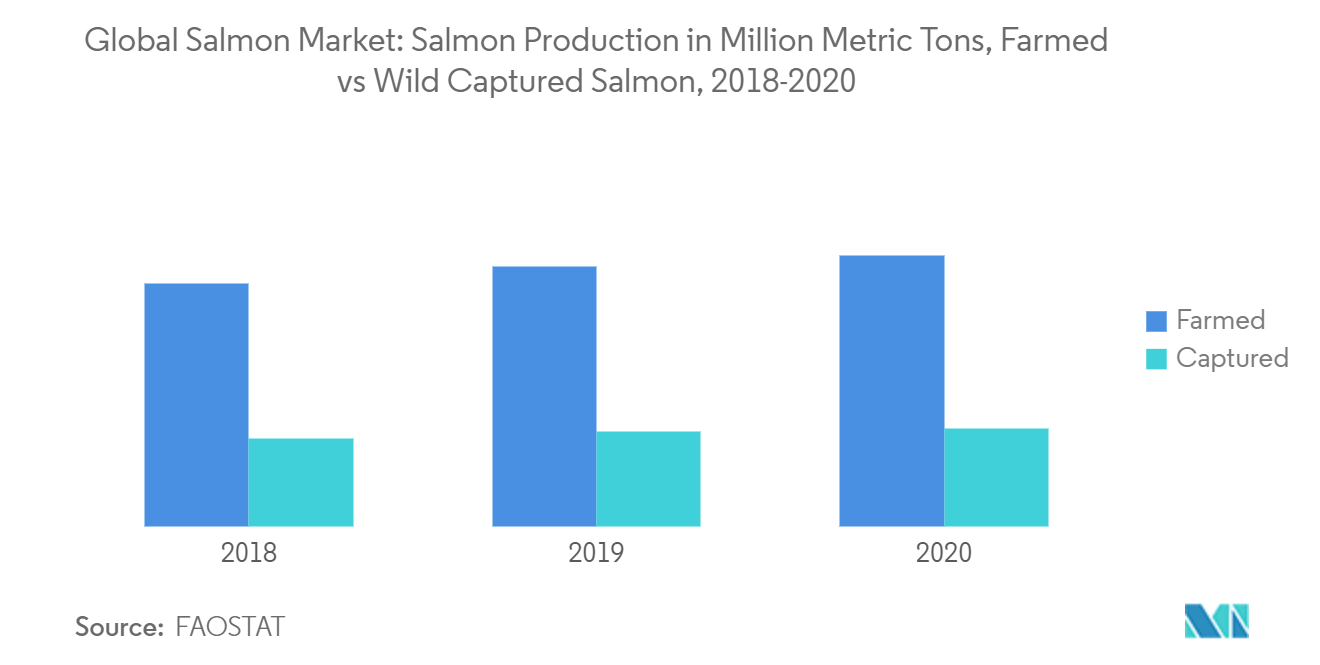Market Trends of Salmon Industry
This section covers the major market trends shaping the Salmon Market according to our research experts:
Healthy Boost in the Salmon Production
The global production of farmed salmon peaked at 2.68 million metric tons in 2020, with Chile's aquaculture sector performance gradually improving over the past few years. This has resulted in increased salmon culture, especially Atlantic salmon culture, which is garnering nearly 74% of the salmon production in the world. The bulk of production increase is observed in Chile, at around 14% from 2018 to 2019, where a new regulatory regime is producing results. Similarly, in Norway, the world's largest producing country, a cold winter and fish health issues translated into a modest 5% increase in salmon harvests.
Moreover, the growth in supply is unable to satiate the salmon demand globally. As demand for salmon continues to strengthen globally, a combination of geographic and regulatory constraints on traditional open net-pen farming has limited the ability of producers to keep pace. However, increasing investments in the salmon production in the Chinese market, coupled with the technological approaches such as land and off-shore based culture and genetically engineered salmon, are some of the potential opportunities for pacing up the production further.

Chile leads the Salmon Market as Norway Grapple with Fish Health
The global supply growth of farmed salmon is led by Chile surpassing the constraints pertaining to the mass algal bloom mortalities, thereby maintaining its profitability. In 2020, more than one million metric ton of salmon were harvested in Chile, the country's highest value produced since 2007 as per Chilean trade body SalmonChile. Farmed salmon production uses 13 times less water, and its carbon footprint is ten times less than that of livestock.
The industry reached an agreement with Monetary Bay Aquarium in 2019 to reduce the use of antibiotics by 25% by 2050. In 2020, the industry lowered its antibiotic use rate to 298 grams-per-MT of biomass harvested, down from the 621 grams-per-metric ton it registered in 2016 and a 14.6% drop from the 349 grams-per-MT it used in 2019.
A relatively lower rate of production growth was observed in Europe, especially in Scotland, during the same period. For the past two years, Norwegian production has also been growing at a relatively slow rate due to regulatory constraints and sea lice difficulties. The total harvest quantity of salmonids in Norway in 2020 amounted to 1.46 million metric ton, representing an increase of 3.5% compared to 2019.
Norway's salmon industry had successfully pushed for bold changes in the supply chains for soya, an important vegetable component of salmon feed. All the Brazilian soy suppliers to the Norwegian salmon farming industry agreed to the implementation of a 100 % deforestation and conversion-free soybean value chain with 2020 as their cut-off date.
The Chilean salmon farming sector achieved very prospecting results. Production costs have fallen, and biological conditions at farms have reportedly improved, reflected in higher harvests that have even surpassed those of Norway. This is particularly driving the efforts to develop new approaches to farming, mainly focused on closed containment technologies, both on land and at sea. Also, new aquaculture operations are being set up in a variety of geographically dispersed countries, such as Iceland, the Russian Federation, and China, which is likely to spike up the salmon supply in the years to come.


